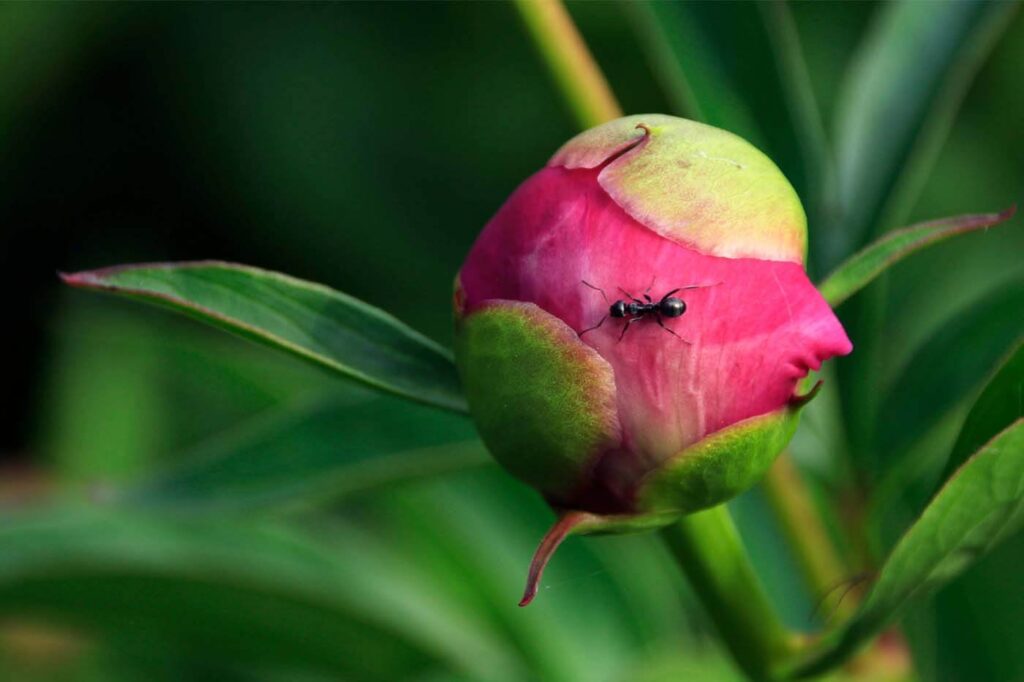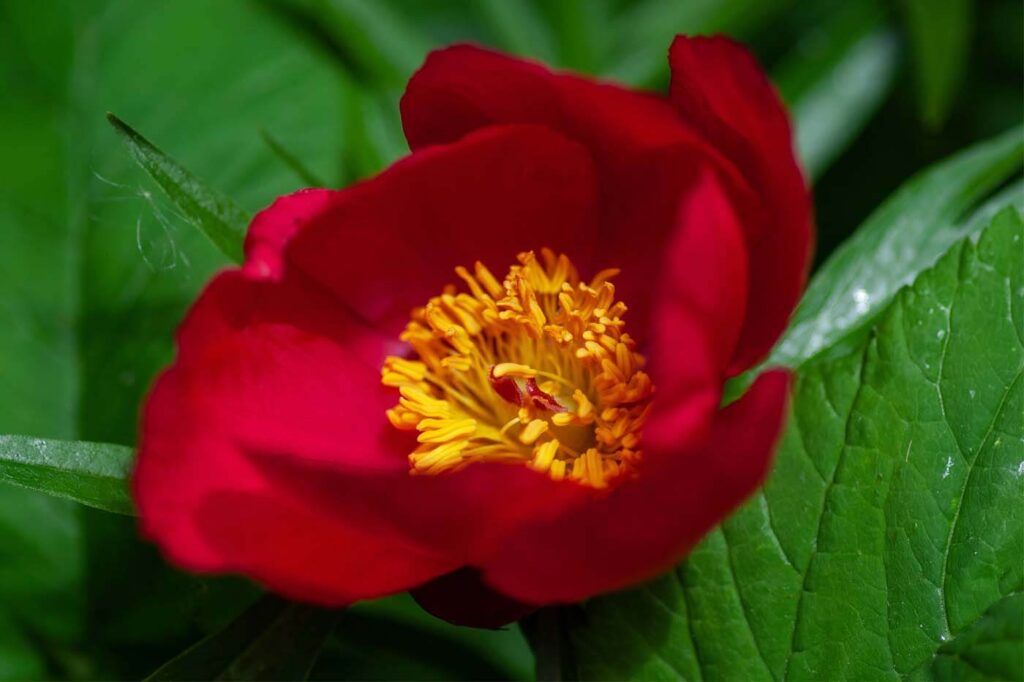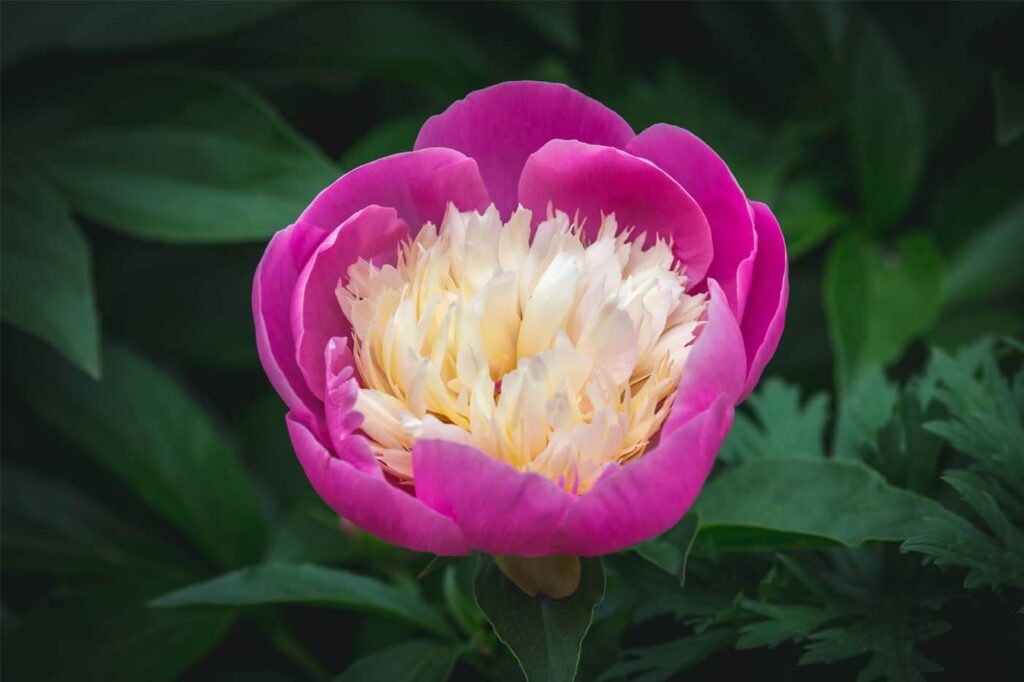Botanical Name: Paeonia spp.
Flower colours: Pink, purple, red, white and yellow
Peonies are perennial herbaceous plants that come back year after year with large, fragrant blooms. They are long-lived, with some lasting up to 100 years old. They require little to no care. Depending on the variety you select, peonies bloom early in the season (May) or into the summer (June or July). I select from five varieties of peonies for my garden designs that work well in our growing region: Itoh, single, semi-double, full double, and the Bomb. All varieties are bush peonies.

FACTS about growing peony
- Peonies are sun-lovers. They require at least six full hours of direct sunlight on the plant per day. The Itoh variety prefers a bit of light shade from the afternoon’s heat.
- Well-drained soil is ideal. Peonies don’t like wet feet (roots) or standing water. Make sure you plant your peony where the soil drains away quickly after it rains. Raised beds are a good location for peonies. Low-lying areas, such as the bottom of a slope, are unsuitable for peonies. Plant peony high and dry.
- Peonies need support when they flower. When peony buds start to open, the flowers quickly become too large and heavy for slender stems to support. As a result, your beautiful blooms go crashing to the ground. Add in rain or wind, and your lovely peony flowers are ruined in a couple of days. If you want to extend the length of time you enjoy your peony flowers, keep them off the ground. Install a peony ring (hoop) or cage above the peony plant before spring growth gets too tall. When you can see about two to three inches of new growth poking out of the ground, it is time to place your peony support.

- Peonies need room to grow. Most peonies tend to grow between three and four feet wide and about three feet tall. If you want beautiful blooms, you need to give peonies room to grow. At least three feet of space, or about the size of a child’s hula hoop, will work. Overcrowding peonies can reduce bloom production.
- Watering peonies. Like any plant, peonies need water in the first two growing seasons to establish roots. Water at least once or twice per week for the first growing season. If the weather is hot, water at least twice per week. Once the peony is established – in the third growing season –reduce watering as it tends to be drought tolerant.
- Feeding peony. Although peonies require little care, you need to feed them if you want great blooms. Feed the peony only once yearly when the new stems reach about two to three inches above the ground (the same time you put in your peony support). Use a low-nitrogen dry fertilizer (5-10-10) placed on the top of the soil around the peony. About a quarter-cup per mature peony plant will do. Water the fertilizer in a well and ensure it doesn’t get stuck in the plant’s crown, where it can burn tender new stems. Overfeeding peonies will lead to tons of green leaf growth; however, there will be little bloom production.
- Planting and transplanting peonies. Peonies may be purchased and planted at any time during the growing season; however, if you want to divide and move peonies, spring and fall are the best times. If you are moving peonies in the fall, cut the leaf stems to the ground before moving. Peony roots look like huge carrots. The trick to moving peony is to try and dig up as much root as possible. Once you have dug your peony roots, shake off as much soil as possible to see the root zone. This is important because you don’t want to plant the roots too deeply when you move them to their new home. Peonies must be planted just below the soil surface – one to two inches below the garden level. Dig a hole large enough to accommodate the roots, ensuring it is shallow. If you need to, add soil to ensure the peony roots sit high. Place the roots so the ‘eyes’ or buds are facing upward. Cover with about one to two inches of soil. You can divide peony root clumps using a knife, ensuring you have at least four to five ‘eyes’ (buds) in each clump. Remember, if you plant peonies too deeply, they won’t bloom. Plant high. Water well after planting. Quick note: Peonys may not bloom in the first spring after planting, as it can take an entire growing season or two to settle in.
Long-blooming peony
For long-lasting peony blooms, it’s essential to water around the plant’s roots rather than the blooms. Hand watering is the most effective method. Use a long-handled wand (spray wand) to apply water around the peony roots. Blooms that receive water from an overhead sprinkler or irrigation system tend to deteriorate more quickly, fading and disappearing within a week. Overhead watering can also encourage powdery mildew on peony leaves.

FABLES about growing peony

- Peony and ants. For years, I believed peonies wouldn’t bloom without ants. This, however, is a fable. What is true is that ants like the waxy coating of the peony buds and harvest the nectar from the peony blooms. In return, ants protect peony blooms from flower-feeding insects like Thrips. Peony and ants have a friendship of sorts. Ants do not harm peony or their blooms in any way. You don’t have to remove the ants or even spray with insecticide. Just leave them alone. They’re working together.
- Placing peony. If you don’t like ants, make sure to plant your peony in a location away from the house.
- Cutting Blooms. If you want to cut and bring peony blooms into your home without ants, carefully shake the blooms by holding the stem close to the bloom so you don’t snap the head from the stem. The best time to cut peonies for indoor use is early morning.
- Peonies are challenging to grow. Not so! Peonies are easy to grow and low maintenance and tend to care for themselves once established. With spring care, peonies will grow happily in your gardens for years.
- Deer and rabbits don’t tend to like peonies. Both deer and rabbits avoid peony blooms. Young deer may nibble on a peony bloom only to find they don’t taste good. Peonies thrive in gardens with wildlife.


The Peony
The light, delicate petals of a peony
like crisp tissue paper balls
with ruffled edges of pink and white.
You can almost smell their sweet fragrance
as they sway in the breeze.
Soft to the touch – lovely to behold.
Reminds me of sweet spring garden dreams.
Lexi Dearborn
The Gabby Gardener
March 2022
